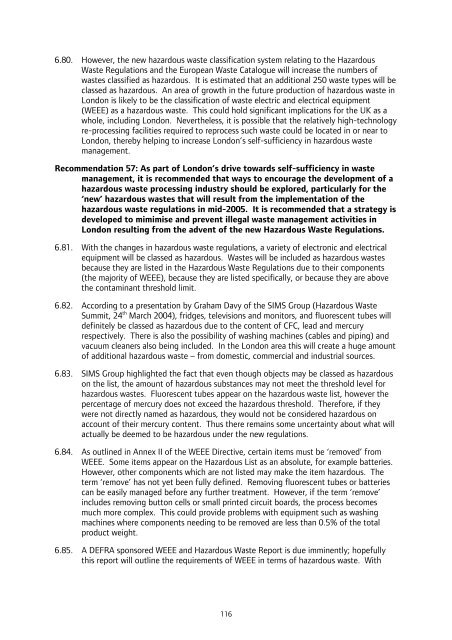London Wider Waste Strategy - London - Greater London Authority
London Wider Waste Strategy - London - Greater London Authority
London Wider Waste Strategy - London - Greater London Authority
You also want an ePaper? Increase the reach of your titles
YUMPU automatically turns print PDFs into web optimized ePapers that Google loves.
6.80. However, the new hazardous waste classification system relating to the Hazardous<br />
<strong>Waste</strong> Regulations and the European <strong>Waste</strong> Catalogue will increase the numbers of<br />
wastes classified as hazardous. It is estimated that an additional 250 waste types will be<br />
classed as hazardous. An area of growth in the future production of hazardous waste in<br />
<strong>London</strong> is likely to be the classification of waste electric and electrical equipment<br />
(WEEE) as a hazardous waste. This could hold significant implications for the UK as a<br />
whole, including <strong>London</strong>. Nevertheless, it is possible that the relatively high-technology<br />
re-processing facilities required to reprocess such waste could be located in or near to<br />
<strong>London</strong>, thereby helping to increase <strong>London</strong>’s self-sufficiency in hazardous waste<br />
management.<br />
Recommendation 57: As part of <strong>London</strong>’s drive towards self-sufficiency in waste<br />
management, it is recommended that ways to encourage the development of a<br />
hazardous waste processing industry should be explored, particularly for the<br />
‘new’ hazardous wastes that will result from the implementation of the<br />
hazardous waste regulations in mid-2005. It is recommended that a strategy is<br />
developed to mimimise and prevent illegal waste management activities in<br />
<strong>London</strong> resulting from the advent of the new Hazardous <strong>Waste</strong> Regulations.<br />
6.81. With the changes in hazardous waste regulations, a variety of electronic and electrical<br />
equipment will be classed as hazardous. <strong>Waste</strong>s will be included as hazardous wastes<br />
because they are listed in the Hazardous <strong>Waste</strong> Regulations due to their components<br />
(the majority of WEEE), because they are listed specifically, or because they are above<br />
the contaminant threshold limit.<br />
6.82. According to a presentation by Graham Davy of the SIMS Group (Hazardous <strong>Waste</strong><br />
Summit, 24 th March 2004), fridges, televisions and monitors, and fluorescent tubes will<br />
definitely be classed as hazardous due to the content of CFC, lead and mercury<br />
respectively. There is also the possibility of washing machines (cables and piping) and<br />
vacuum cleaners also being included. In the <strong>London</strong> area this will create a huge amount<br />
of additional hazardous waste – from domestic, commercial and industrial sources.<br />
6.83. SIMS Group highlighted the fact that even though objects may be classed as hazardous<br />
on the list, the amount of hazardous substances may not meet the threshold level for<br />
hazardous wastes. Fluorescent tubes appear on the hazardous waste list, however the<br />
percentage of mercury does not exceed the hazardous threshold. Therefore, if they<br />
were not directly named as hazardous, they would not be considered hazardous on<br />
account of their mercury content. Thus there remains some uncertainty about what will<br />
actually be deemed to be hazardous under the new regulations.<br />
6.84. As outlined in Annex II of the WEEE Directive, certain items must be ‘removed’ from<br />
WEEE. Some items appear on the Hazardous List as an absolute, for example batteries.<br />
However, other components which are not listed may make the item hazardous. The<br />
term ‘remove’ has not yet been fully defined. Removing fluorescent tubes or batteries<br />
can be easily managed before any further treatment. However, if the term ‘remove’<br />
includes removing button cells or small printed circuit boards, the process becomes<br />
much more complex. This could provide problems with equipment such as washing<br />
machines where components needing to be removed are less than 0.5% of the total<br />
product weight.<br />
6.85. A DEFRA sponsored WEEE and Hazardous <strong>Waste</strong> Report is due imminently; hopefully<br />
this report will outline the requirements of WEEE in terms of hazardous waste. With<br />
116
















